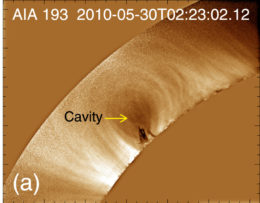The dramatic image above reveals the expansion of a large coronal cavity as it erupts from the Sun’s surface in the form of a coronal mass ejection. This is a combination of LASCO (background) and SWAP (overlay) observations; click to see the larger field, which spans 3 x 5 solar radii (the white quarter-circle marks one solar radius). To better understand what triggers powerful solar ejections, a team of scientists led by Ranadeep Sarkar (Udaipur Solar Observatory, India) has pieced together observations over time of a coronal cavity that was witnessed in 2010. This low-density cavity formed above the Sun’s surface and hung peacefully in the lower corona for nearly two weeks before erupting violently in a surge of plasma and radiation.

This image of the cavity was taken with SDO nearly two weeks before the LASCO/SWAP image above. Here, the cavity is much smaller and sits in the lower corona above a prominence. [Adapted from Sarkar et al. 2019]
Citation
“Evolution of the Coronal Cavity From the Quiescent to Eruptive Phase Associated with Coronal Mass Ejection,” Ranadeep Sarkar et al 2019 ApJ 875 101. doi:10.3847/1538-4357/ab11c5

1 Comment
Pingback: Daily Study Log (2019-05-07) | Study Astrophysics